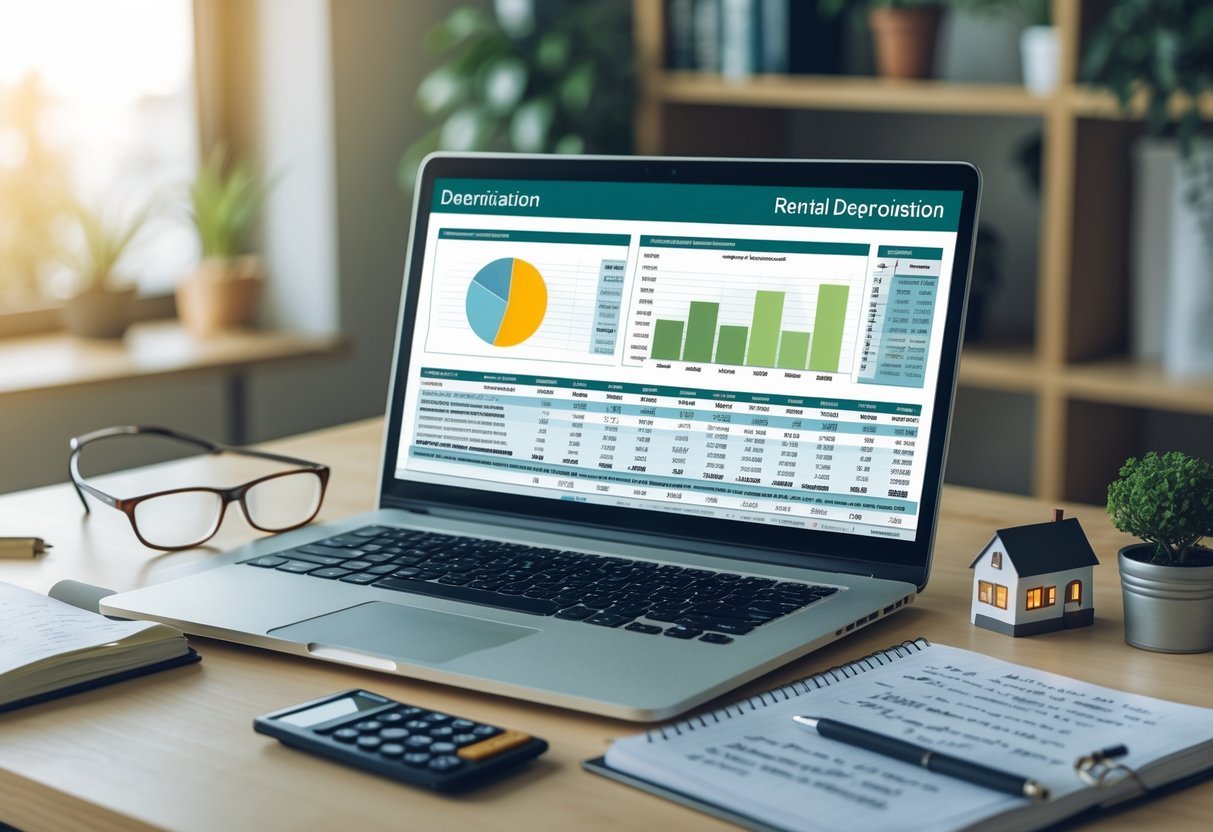Real estate depreciation offers property investors a powerful tax advantage that can significantly reduce their annual tax burden. Rental property depreciation allows you to deduct the cost of your investment property over time, typically 27.5 years for residential properties, which can lead to substantial tax savings each year.
When you own rental property, the IRS recognizes that buildings and improvements naturally wear down over time. Depreciation deductions apply to the property’s structure and components – not the land itself – and serve as a way to recover your initial investment costs while generating passive income.
This tax benefit continues throughout the property’s designated recovery period, regardless of whether your property actually decreases in market value. You can start taking depreciation deductions as soon as you place the property in service for rental purposes.
Key Takeaways
- Depreciation allows you to deduct the cost of your rental property over a set period while reducing your taxable income
- You must segregate the cost of land from the building since only structures and improvements qualify for depreciation
- Tax benefits from deductions like depreciation continue even if your property increases in market value
What Is Real Estate Depreciation?
Real estate depreciation enables property investors to deduct the cost of their investment properties over time through annual tax deductions. This tax benefit recognizes that buildings deteriorate and lose value as they age.
Definition and Core Concepts
Rental property depreciation lets you write off the purchase price and improvement costs of your investment property across its designated useful life. The IRS considers residential properties to have a 27.5-year useful life.
When you claim depreciation, you’re accounting for the natural decline in your property’s condition and value due to age and use. This includes wear and tear on the building structure, roof, HVAC systems, and other components.
Key Elements of Depreciation:
- Purchase price of the building (excluding land)
- Capital improvements and renovations
- Property’s useful life per IRS guidelines
Real Estate Depreciation vs. Other Types of Depreciation
Real estate depreciation differs from other asset depreciation because buildings have a much longer useful life than equipment or vehicles. While a car might depreciate over 5 years, your rental property’s cost is spread across decades.
Real estate depreciation only applies to income-producing properties. Your primary residence doesn’t qualify for this tax benefit.
The land value of your property cannot be depreciated since land doesn’t wear out or become obsolete.
Purpose and Significance in Real Estate
Tax deductions through depreciation help reduce your taxable rental income each year. This benefit makes real estate investing more financially attractive and acknowledges the ongoing costs of property ownership.
You can start claiming depreciation as soon as you place the property in service for rental activities. The deduction continues until you’ve fully depreciated the property or you sell it.
Benefits for Investors:
- Lower annual tax liability
- Improved cash flow
- Recognition of property aging and deterioration
- Offset for maintenance and replacement costs
How Depreciation Works for Rental Properties
Rental property depreciation allows you to deduct the cost of income-producing properties over time, reducing your taxable income. The depreciation calculation depends on the property type and its cost basis.
Residential Rental Property Depreciation
You can depreciate residential rental properties over 27.5 years using the Modified Accelerated Cost Recovery System (MACRS).
To calculate your annual depreciation deduction, divide your property’s cost basis by 27.5. This equals approximately 3.636% of the cost basis per year.
Your cost basis includes the purchase price plus improvements, but excludes the value of the land since land cannot be depreciated.
Nonresidential Building Depreciation
Commercial and other nonresidential buildings have a longer depreciation period of 39 years under MACRS.
The annual depreciation calculation for nonresidential buildings follows the same principle – divide the cost basis by 39 years to determine your yearly deduction amount.
This longer recovery period means you’ll receive smaller annual deductions compared to residential properties.
Useful Life and Recovery Periods
Standard Recovery Periods:
- Residential rental property: 27.5 years
- Nonresidential buildings: 39 years
- Land improvements: 15 years
- Appliances and furniture: 5-7 years
You must begin taking depreciation when you place the property in service as a rental. The IRS requires you to take depreciation deductions even if you choose not to claim them.
The property must be used in your business or income-producing activity to qualify for depreciation.
Calculating Real Estate Depreciation
Real estate depreciation allows property investors to deduct a portion of their property’s value each year as a tax benefit. The annual deduction amount depends on the property’s cost basis, land-to-building ratio, and depreciation method.
Determining the Cost Basis
Your property’s cost basis includes the purchase price plus eligible acquisition costs. Add expenses like legal fees, transfer taxes, and title insurance to your original purchase price.
Before calculating depreciation, you must separate any personal property items that have different depreciation schedules, such as:
- Appliances
- Window treatments
- Carpet and flooring
- HVAC systems
Keep detailed records of improvement costs made after purchase, as these increase your cost basis.
Allocation Between Land and Building
You can only depreciate the building portion of your property, not the land. To determine the building value:
- Review your property tax assessment for the land-to-building ratio
- Request a professional appraisal
- Use comparable sales data in your area
For example, if your property cost $300,000 and the building represents 85% of the value, your depreciable basis would be $255,000.
Methods of Depreciation Calculation
The IRS requires residential rental properties to use the Modified Accelerated Cost Recovery System (MACRS) over 27.5 years. Calculate your annual depreciation by dividing your building’s cost basis by 27.5.
Your annual depreciation deduction = Building Cost Basis ÷ 27.5
For a building valued at $255,000: $255,000 ÷ 27.5 = $9,272 annual depreciation deduction
Commercial properties use a 39-year depreciation period instead of 27.5 years.
Depreciation Deductions and Tax Benefits
Depreciation deductions for rental property allow you to recover property costs through annual tax write-offs. These deductions represent a significant financial advantage for real estate investors and property owners.
Depreciation as a Tax Deduction
Property depreciation enables tax deductions on your rental property for up to 27.5 years for residential properties and 39 years for commercial properties.
You can begin taking depreciation deductions as soon as you place the property in service for rental purposes.
The property must meet specific criteria to qualify:
- Used for income-producing purposes
- Has a determinable useful life
- Expected to last more than one year
Impact on Taxable Income
Depreciation directly reduces your taxable rental income. For example, if you earn $20,000 in rental income and claim $5,000 in depreciation, you only pay taxes on $15,000.
When you sell the property, you’ll need to account for depreciation recapture, which is taxed at up to 25%.
Tax benefits from depreciation continue annually until you’ve recovered all allowable costs or stop using the property for rental purposes.
Common Tax Planning Strategies
Consider these effective approaches to maximize depreciation benefits:
- Component depreciation: Separate building components to depreciate them on different schedules
- Cost segregation studies: Identify and reclassify property components for faster depreciation
- Strategic timing of improvements: Plan upgrades to maximize available deductions
Track all capital improvements carefully, as these can be added to your depreciable basis.
Schedule regular property assessments to identify new depreciation opportunities.
Special Rules and Types of Depreciation
The IRS provides several specialized depreciation methods and rules that can significantly reduce your tax burden when properly applied to real estate investments. These options allow for accelerated deductions in specific scenarios.
Bonus Depreciation
Bonus depreciation rules allow you to immediately deduct a large percentage of eligible property costs in the first year of service. For property placed in service through 2025, you can claim 80% bonus depreciation.
This accelerated depreciation applies to new and used property with a recovery period of 20 years or less.
You must opt out of bonus depreciation if you prefer to use standard depreciation methods. This decision applies to all assets within the same property class for that tax year.
Qualified Improvement Property (QIP)
QIP includes interior improvements made to nonresidential buildings after they were placed in service. This excludes enlargements, elevators/escalators, and internal structural framework.
QIP qualifies for a 15-year recovery period under MACRS instead of 39 years. This shorter period allows for faster depreciation of eligible improvements.
You can combine QIP with bonus depreciation for maximum tax benefits in the first year.
Depreciation for Security Systems
Security systems are typically classified as 5-year or 7-year property under MACRS depreciation rules.
Built-in security systems that are part of the building structure follow the building’s 27.5-year (residential) or 39-year (commercial) depreciation schedule.
Removable security equipment like cameras and monitoring devices can be depreciated more quickly using the 5-year or 7-year property classification.
Limits, Recapture, and Compliance
Real estate depreciation offers significant tax advantages, but strict IRS rules govern its use and eventual recapture when selling property. You must carefully track and report depreciation to maintain compliance and avoid penalties.
Limitations and Exceptions
The maximum Section 179 deduction for 2024 is $1,220,000 for qualifying property. This limit reduces dollar-for-dollar when you place more than $2,590,000 of qualifying property in service.
You must use straight-line depreciation for residential rental properties over 27.5 years and commercial properties over 39 years.
Certain property improvements and land cannot be depreciated. The land portion of your real estate investment always maintains its original tax basis.
Recapture Rules When Selling Property
Real estate depreciation recapture is taxed at a maximum rate of 25% when you sell a property for a profit. This applies to the portion of your gain related to prior depreciation deductions.
Your total gain calculation must include depreciation recapture even if you didn’t claim depreciation deductions. The IRS assumes you took all allowable depreciation.
The recapture amount becomes part of your taxable income in the year of sale. You report this on Form 4797.
IRS Compliance Requirements
You must maintain detailed records of all depreciation claims, including purchase price allocation, improvement costs, and annual depreciation amounts.
Report your depreciation deductions annually on Schedule E for rental properties or Form 4562 for business properties.
Keep supporting documentation for at least three years after filing the return in which you dispose of the property or claim the final depreciation deduction.
Consider creating a depreciation schedule at purchase to track your deductions systematically and ensure accurate reporting.
Common Mistakes and Best Practices in Real Estate Depreciation
Proper depreciation practices can significantly impact your tax benefits and investment returns. Accurate calculations, thorough documentation, and professional guidance form the foundation of effective real estate depreciation strategy.
Errors in Depreciation Calculation
Failing to separate land value from building value represents a critical error that can trigger IRS audits. Land cannot be depreciated, so you must clearly distinguish between these components.
Using incorrect recovery periods for different property components can reduce your tax advantages. Standard residential properties use a 27.5-year period, while commercial properties require 39 years.
Cost segregation studies can help identify components eligible for shorter depreciation periods. These studies often reveal opportunities to accelerate deductions through 5-, 7-, or 15-year property classifications.
Recordkeeping and Documentation
Maintaining detailed records of purchase prices, improvement costs, and depreciation calculations is essential. Create digital backups of all receipts, invoices, and tax documents.
Track these key items:
- Purchase closing statements
- Renovation and improvement receipts
- Annual depreciation amounts
- Property assessment records
Set up a dedicated spreadsheet or accounting software to monitor depreciation schedules. Review these records quarterly to ensure accuracy and completeness.
Working With Tax Professionals
Engage a qualified CPA or tax advisor with real estate expertise. Regular consultations help identify optimization opportunities and prevent costly mistakes.
Schedule annual tax planning meetings to review depreciation strategies and discuss any property improvements or changes.
Consider having your depreciation calculations professionally reviewed every 2-3 years to ensure compliance and maximize benefits. Your tax professional can help identify opportunities for cost segregation and bonus depreciation.
Real Estate Depreciation FAQ
Property owners can deduct depreciation expenses on rental properties to reduce their taxable income. Tax deductions for rental property depreciation allow investors to account for wear and tear on buildings and improvements over time.
What is the Useful Life for Real Estate Depreciation?
The IRS requires residential rental properties to be depreciated over 27.5 years using the Modified Accelerated Cost Recovery System (MACRS). Commercial properties must be depreciated over 39 years.
Rental property owners can claim depreciation starting when they place the property in service as a rental until they either sell it or take it out of service.
How Does the IRS Calculate Depreciation on Rental Properties?
Take the property’s cost basis (purchase price plus improvements, minus land value) and divide by 27.5 years for residential rentals.
Land value cannot be depreciated since it does not wear out or become obsolete. You must subtract the land value from your property’s cost basis before calculating depreciation.
What are the Current IRS Guidelines for Real Estate Depreciation?
Property owners must use the Modified Accelerated Cost Recovery System (MACRS) for depreciation calculations.
Rental properties placed in service after 1986 use MACRS guidelines, which dictate set recovery periods and depreciation methods.
Which Property Improvements Can Be Depreciated?
Capital improvements that add value or extend the useful life of the property can be depreciated. This includes new roofs, additions, HVAC systems, and major renovations.
Repairs and maintenance cannot be depreciated and must be deducted as regular expenses in the year paid.
Are There Income Limits for Depreciation Deductions?
There are no income limits for claiming rental property depreciation deductions. Any property owner who meets the basic requirements can claim depreciation.
Active real estate investors may face passive activity loss limitations that restrict their ability to deduct losses, but this does not affect depreciation calculations.
What is an Example of Real Estate Depreciation?
A rental home purchased for $275,000 with land valued at $75,000 has a depreciable basis of $200,000. The annual depreciation deduction would be $7,272.73 ($200,000 ÷ 27.5 years).
This amount can be deducted each year for 27.5 years, starting when the property is placed in service as a rental.



